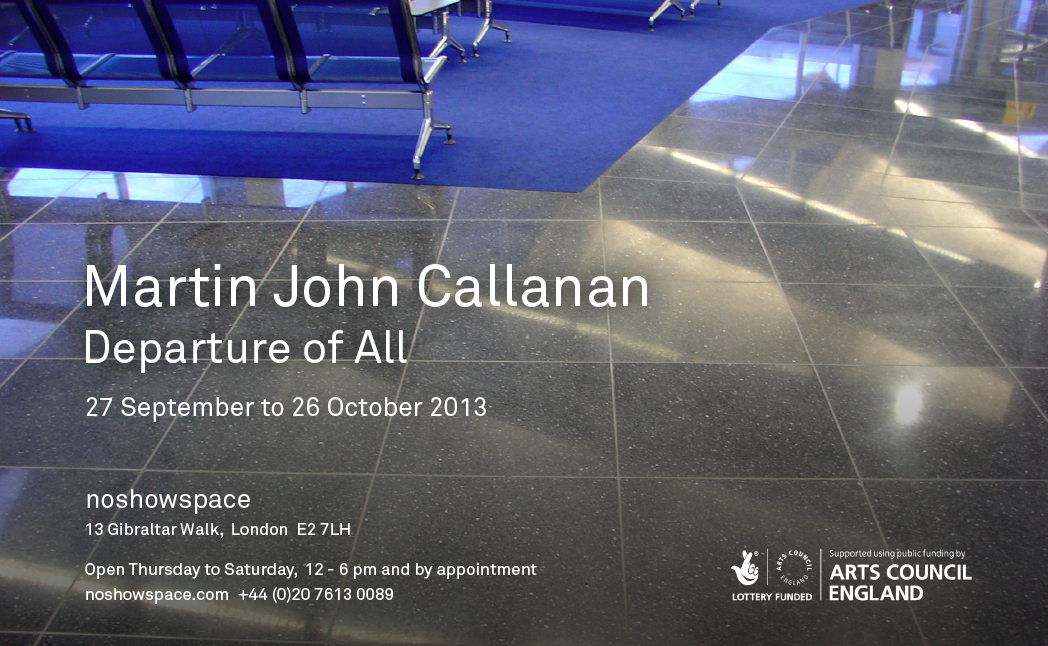Posts in Category ‘exhibition’
Departure of All, noshowspace
How to Construct a Time Machine, MK Gallery, Milton Keynes
23 January – 22 March 2015
Preview 22 January 2015 / 6-10pm
MK Gallery, 900 Midsummer Boulevard, Central Milton Keynes, MK9 3QA.
Admission is free
January 2015 MK Gallery presents How to Construct a Time Machine (23 January – 22 March 2015), an exhibition of over twenty-five historical and contemporary works that explore how artists play with media in innovative ways to transform our experience of time.
What is time? How do we order the past, the present, and the future? Why are artists interested in time? How is art a machine, vehicle, or device for exploring time? How is art a means by which time ‘travels’, and how does art permit us to travel in time? Consideration of these and other questions has provided the exhibition rationale for guest curator, Dr Marquard Smith, Head of Doctoral Studies/Research Leader in the School of Humanities at the Royal College of Art, London.
The show’s title is taken from an 1899 text by the avant-garde French writer, Alfred Jarry, written in direct response to H. G. Wells’ science fiction novel The Time Machine (1895). Wells invented and popularised a distinctively modern, fictional concept of time travel, with the time machine as a vehicle that could be operated ‘selectively’.Jarry’s response crafted a pseudo-scientific fiction that presents the time machine and time travel as an instance of ‘the science of imaginary solutions’.
Taking this idea of the time machine, time travel, and perhaps even time itself as an instance of ‘the science of imaginary solutions’, the exhibition is divided thematically across the galleries and includes works by John Cage, Martin John Callanan, Jim Campbell, Edgar Cleijne and Ellen Gallagher, Matt Collishaw, Ruth Ewan, Tehching Hsieh, the Lumière Brothers, Chris Marker, Kris Martin, Manfred Mohr, Melvin Moti, Nam June Paik, Katie Paterson, Elizabeth Price, The Otolith Group, Raqs Media Collective, Meekyoung Shin, Sun Ra, Thompson & Craighead, Mark Wallinger and Catherine Yass, amongst others.
Film work ranges from George Méliès’ A Trip to the Moon (1902), an iconic silent movie which follows a group of astronomers as they explore the moon, to Thomson & Craighead’s The Time Machine in alphabetical order (2010), a complete rendition of the 1960s film version of the Wells’ novella re-edited into alphabetical order.
Sculptural work includes Mark Wallinger’s Time and Relative Dimensions in Space (2001), an aluminium version of Dr Who’s ‘Tardis’ police box that simultaneously disappears into the space-time continuum and reflects its own surroundings, and Ruth Ewan’s We Could Have Been Anything That We Wanted to Be (2012), a decimal clock which divides the day into ten (rather than twenty-four) periods, echoing a bold 18th century French Republican attempt to redefine and rationalise the day.
The exhibition will be accompanied by a catalogue, designed by Herman Lelie, featuring an extended Introduction by the exhibition’s curator and a translation of Jarry’s How to Construct a Time Machine, together with essays by Dutch cultural theorist and video artist Mieke Bal and radical philosopher Peter Osborne. The exhibition will be supported by a range of related events including tours by the curator and artists, seminars, academic conferences, and film screenings.
Departure of All, Noshowspace, Bethnal Green, London
27 September – 26 October 2013, noshowspace, 13 Gibraltar Walk, Bethnal Green, London
noshowspace is pleased to present Departure of All, Martin John Callanan’s first solo exhibition in London.
Callanan is intrigued by systems present in society that shape our lives yet remain largely unobserved. In a process of research he makes simple and direct requests to international organisations and authorities, including open data sources. Through collating and presenting the often excessive results his work becomes an all inclusive, all embracing reflection of our wider world. In Departure of All Callanan will be showing Wars During My Lifetime, Grounds and a new work titled Departure of All.
Departure of All is a flight departure board displaying flight information for every departure happening from all international airports around the world. The familiar wait in front of the departure board is replaced with an accelerated stream of flight departure times, given poignancy by the fact they are real flights that can be mapped to real places in real time. The world as one airport.
In Grounds, a work of long term research started in 2003, Callanan seeks to negotiate permission to take a single photograph in buildings important to society but where photography is not permitted. His ongoing photographic archive currently contains about 2000 locations from across the world, a selection of which are on show.
Wars During My Lifetime is a newspaper, listing every war fought during the course of the artist’s life. It is an evolving work first published in 2012, a third edition is published on the occasion of this exhibition.
Martin John Callanan (b. 1982) lives and works between London and Berlin. Recent exhibitions include ‘Open Cube’, White Cube, Mason’s Yard, London (2013); ‘Along Some Sympathetic Lines’, Or Gallery, Berlin (2013); Whitstable Biennale (2012); Harrach Moya Gallery, Palma (2012) and ‘Deed Poll’, a performance at Whitechapel Gallery London (2012). Callanan graduated from The Slade School of Fine Art in 2005 and is currently a Teaching Fellow in Fine Art Media at the Slade School of Fine Art, University College London.
A publication accompanies the exhibition with contributions from Pau Waelder and Domenico Quaranta.
Part of Art Licks Weekend
Possession at Bangkok Art and Culture Centre, Bangkok, Thailand

14 March – 26 May 2013
“7 Days in June” a 10.5m long, floor based print work from Susan Collins’ Seascape Series is included in this international group exhibition curated by Brian Curtin and Steve Dutton, which also includes Slade alumna Tintin Cooper
Location: Main Gallery, 8th floor
Bangkok Art and Culture Centre
939 Rama 1 Road, Wangmai, Pathumwan, Bangkok 10330
Please click here to download a PDF version of the Exhibition Catalogue (10MB)
Please click here for more information
Along Some Sympathetic Lines, Or Gallery, Berlin
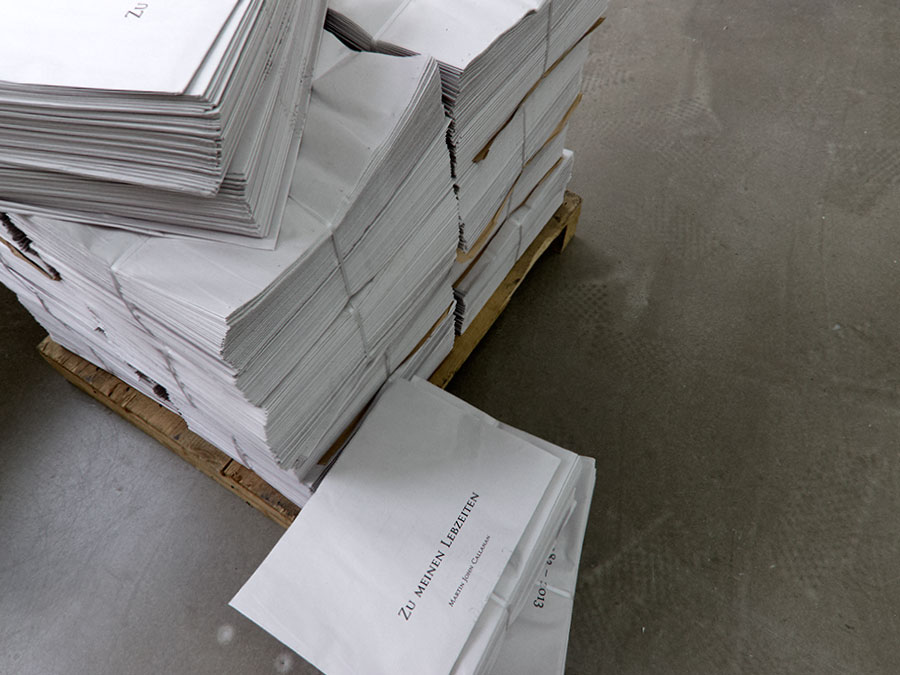
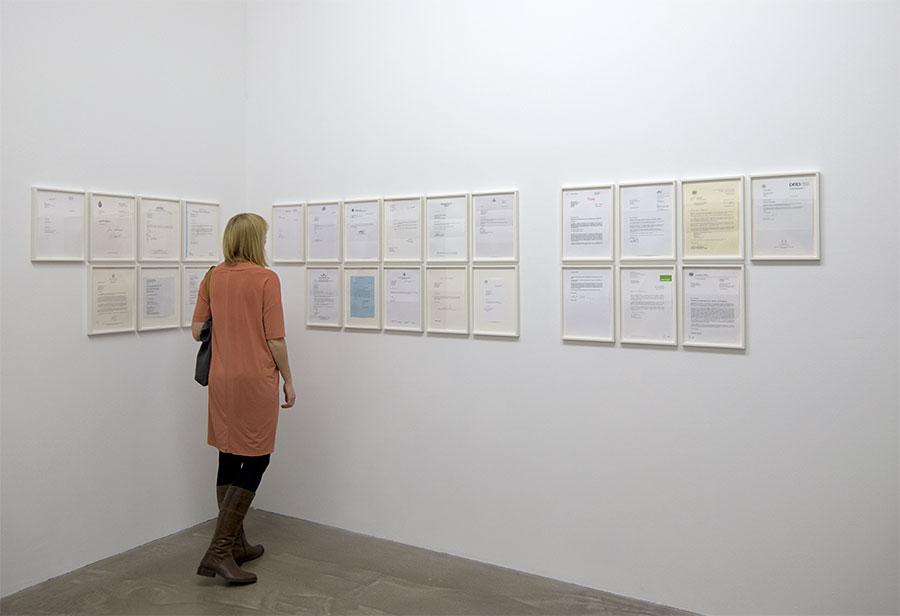

23 February – 27 April 2013
Opening 7pm, 22 February 2013
Or Gallery, Oranienstr 37, Berlin 10999, Germany
Or Gallery is pleased to present Along Some Sympathetic Lines, an exhibition of artwork by London-based artist Martin John Callanan, and an archive project by curator Liz Bruchet. The exhibition considers the poetic possibilities of data and its documentation, and the tenuous process of making meaning.
Martin John Callanan is an artist researching an individual’s place within systems. Callanan generates and reworks photographs, letters and electronic data into evidence of exchanges – between the individual, the institution and the networks of power that intertwine them. The exhibition presents four of the artist’s series: The Fundamental Units, the result of amassing millions of pixels of data, to photographs, in microscopic detail far beyond the capacity of the human eye, the lowest monetary unit of each of the 166 active currencies of world, only to enlarge and print them to vast scale; Wars During My Lifetime, an evolving newspaper listing of every war fought during the course of the artist’s life; Grounds, an ongoing photographic archive which charts ‘important places’ in the world where security restrictions limit the image to the carpeted, tiled or concrete floors; and Letters 2004-2006, Callanan’s correspondence with various heads of states and religious leaders which implicate them in conversations that question their very rationale of their authority. These acts of excavating, accumulating and visualising data draw out the sympathetic aspects within documentation and in so doing, mark and disrupt the underlying power dynamics.
A second gallery features an archive project by London-based curator Liz Bruchet. The display of ephemera from the personal archive of the curator’s grandfather, a Canadian insurance salesman and aspiring radio presenter, takes its inspiration from a found audio recording – part monologue, part autobiography, and part radio show – made in 1974. Harnessing the impulses of the collector, archivist and biographer, the curator reasserts her role as custodian and caretaker to nurture narratives and give weight to the subjective remnants of one man’s life.
This exhibition is curated by Liz Bruchet.
The exhibition is possible with the generous support of Or Gallery, the National Physical Laboratory, and UCL European Institute.
With thanks to Galeria Horrach Moya, (Hiper)vincles, Whitechapel Gallery, Book Works, David Karl, and Pau Waelder.
Text Trends newspaper: Environmental
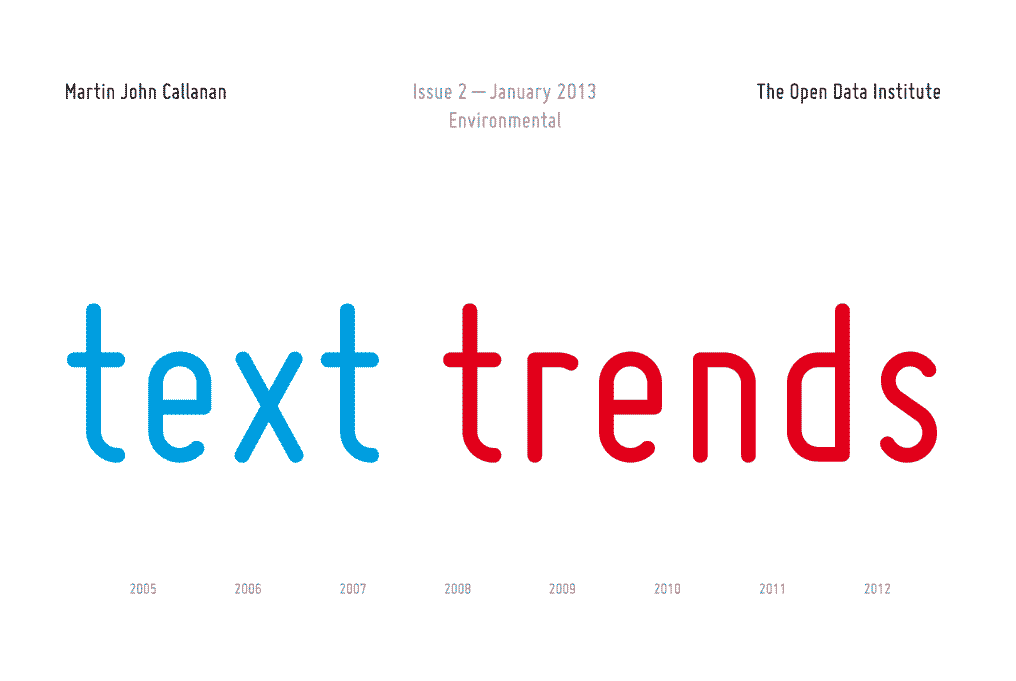
The second issue of Callanan’s Text Trends newspaper, looking at environmental data, will be available in limited numbers from 14 January 2013 at The Open Data Institute.
Over the past twenty years, global climate change has emerged as the overarching narrative of our age, uniting a series of ongoing concerns about human relations with nature, the responsibilities of first world nations to those of the developing world, and the obligations of present to future generations. But if the climate change story entered the public realm as a data-driven scientific concept, it was quickly transformed into something that the ecologist William Cronon has called a ‘secular prophecy’, a grand narrative freighted with powerful, even transcendent languages and values. And though climate science can sometimes adopt the rhetoric of extreme quantification, it also — as has been seen throughout this book — relies on the qualitative values of words, images and metaphors. This can even happen simultaneously: during the discussions that led up to the IPCC’s Third Assessment Report of 2001, for example, a room full of scientists discussed for an entire week whether or not to include the three-word phrase ‘discernable human influence.’ Only three words, perhaps, but three extremely potent words (both qualitatively and quantitavely speaking), that between them tell a vast and potentially world-altering story.
Martin John Callanan’s ongoing Text Tends series offers a deadpan encounter with exactly this kind of quantification of language. Using Google data the series explores the vast mine of information that is generated by the search engine’s users, each animation taking the content generated by search queries and reducing the process to its essential elements: search terms vs. frequency of search over time, presented in the form of a line graph.
In the online manifestation of the Text Trends animations the viewer watches as the animations plot the ebb and flow of a series of paired search terms keyed into Google over the last ten years by Internet users around the world. In the case of the environment sequence featured here, pairs of words such as: ‘nature’ — ‘population’; ‘climate’ — ‘risk’; ‘consensus’ — ‘uncertainty’; ‘Keeling curve’ — ‘hockey stick’, spool out matter-of-factly, like a live market index, allowing the implied narrative content of these word comparisons (along with their accumulated cultural and emotional baggage) to play themselves out before us. In contrast to the hyperinteractivity of emerging news aggregators and information readers, Text Trends explores our perceptions of words presented as connotation-rich fragments of continually updated time-sensitive data.
As an investigation into both the generation and representation of data, Text Trends offers a visual critique of the spectacularization of information, a cultural tic that continues to generate the endless roll of statistically compromised wallpaper that surrounds so much public science debate, and which our book — Data Soliloquies — has in large part been about.
Richard Hamblyn
original version published in Data Soliloquies, UCL Environment Institute, 2009. ISBN 9780903305044
ISSN 2051-6126
ISBN 9781907829086
Inter Sections: Science in Contemporary Art at the Weizmann Institute, Israel

22 September – 7 December 2012
Susan Collins and Slade alumnus Conrad Shawcross are included in this exhibition about meeting points between science and art at the David Lopatie Conference Centre at the Weizmann Institute of Science curated by Cathy Wills. Included are 60 works by 34 artists from around the world; each investigates various aspects of science, theory and technology: genetics, alternative energy, research into the nature of the universe and more.
Seascape at Osterwalder’s Art Office, Hamburg

9 September 2012 – 15 March 2013 (closed 3-16 October)
A solo show of prints from the Seascape archive are showing in Hamburg at Osterwalder’s Art Office
Osterwalder´s Art Office
Isestrasse 37
20144 Hamburg
Germany
Tel. ++ 040 486109
Fax. ++ 040 46882425
gallery@osterwaldersartoffice.com
Opening Hours: Wed – Thu 2 p.m. to 6 p.m. / Fr 11 a.m. – 6 p.m.
Saturday by appointment
Born in 1987: The Animated GIF
at The Photographer’s Gallery

19 May – 1 July 2012
An Animated GIF from the opening sequence of Love Brid is currently screening on ‘The Wall’ at the all new Photographers’ Gallery.
‘The Wall’ is a flat screen video wall hosting the Gallery’s new digital programme. ‘Born in 1987: The Animated GIF’, is its first exhibition. The gallery invited contributions from a range of practitioners resulting in over 40 animated GIFs which will be joined later in the show by contributions from members of the public.
click here to see animated gif
The Photographer’s Gallery
16 – 18 Ramillies Street, London W1F 7LW
Monday – Saturday 10.00 – 18.00
Thursday 10.00 – 20.00
Sunday 11.30 – 18.00
Extimacy: the intimate is Other
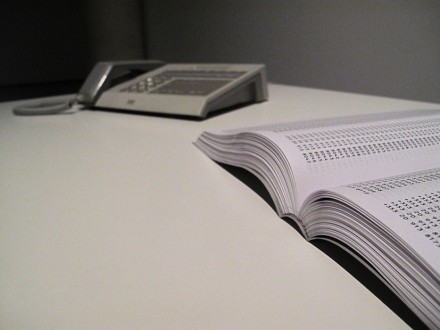
EXTIMACY
ART, INTIMACY AND TECHNOLOGY
Es Baluard Museu d’Art Modern i Contemporani de Palma
29.01.2011 – 01.05.2011
GAZIRA BABELI, CLARA BOJ, MARTIN JOHN CALLANAN, GRÉGORY CHATONSKY, DIEGO DÍAZ, RAFAEL LOZANO-HEMMER, LAURENT MIGNONNEAU, PAUL SERMON, CHRISTA SOMMERER, CARLO ZANNI.
Inside the immense flow of data exchange, the new technologies have facilitated an interdependency between the spheres of what is private and what is public, between interior and exterior, leading us to reveal, in an increasingly natural manner, our experiences, thoughts and feelings, enlarging the circle of intimacy to the point of sharing our inner life with the invisible, abstract audience of Internet users. Things personal become collective, things belonging to others become our own and intimacy is no longer something that is preserved and kept in our innermost circles, but something that is projected in all directions in an eccentric movement. Thus intimacy turns into extimacy, to use the term created by Jacques Lacan to define the existence, within the most intimate sphere of the I, of a “foreign body”, that which is external to the individual and with which one identifies.
We need to share our intimacy because what we are is defined both by our subjectivity and by what surrounds us. In the realm of digital art, several artists have worked with the new parameters of subject, body, interpersonal relationship and intimacy introduced by the new technologies. Their works enable us to initiate a reflection on the ways in which the mobile phone, e-mails, chats, social networks and instant messaging systems modify, increase or condition our communication with others. They also allow us to consider where the boundaries of our personal space lie, where our “I” ends and that of others begins.
“Extimacy. Art, intimacy and technology” is a group digital art exhibition which puts forward a proposal that spectators reflect on these concepts through the presentation of works by recognised artists from the international scene. Interactive installations, mainly, that involve spectators in what is active participation with the work, which never ceases to be a piece with its own identity, the fruit of the firm artistic background of creators who combine art and technology in their work. In an era in which the user adopts an active role in the diffusion and manipulation of information on the global network (known as web 2.0), in art, too, a change in roles between spectator and work is taking place, with interactive art as the best expression of this new paradigm. The works of some great names from this sphere, such as Christa Sommerer and Laurent Mignonneau, Rafael Lozano-Hemmer or Paul Sermon, for instance, are combined with the creations of promising artists like Gazira Babeli, Clara Boj and Diego Díaz, Gregory Chatonsky, Carlo Zanni or Martin John Callanan. All of them exhibit the multiple facets a concept as complex and at the same time as simple as extimacy can present, from different angles and with diverse intentions.
Several Interruptions
To celebrate 15 years of ground breaking research in electronic media, the Slade Centre for Electronic Media in Fine Art (SCEMFA) will hold a 14 week exhibition, showing new works from eight internationally acclaimed artists: who use emerging practices to explore electronic and digital media, as both a source and material.
Martin John Callanan, 24 – 30 January
Thomson & Craighead, 2 – 13 February
Tim Head, 15 – 20 February
Simon Faithfull, 22 February – 6 March
Brighid Lowe, 8 – 13 March
Melanie Jackson, 15 – 20 March
Susan Collins, 23 March – 17 April
An exhibition that revolves every fortnight between each artist, acting as a showcase for the best of contemporary art in the UK, and highlighting the Slade’s pivotal role in the history, development and current research in the many varied forms of electronic media.
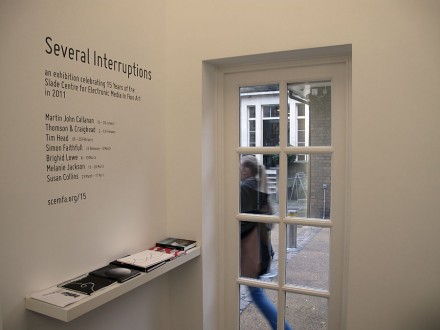
Tuesday – Friday: 10 am – 5pm, Saturday & Sunday: noon – 5pm
North Lodge, University College London, Gower Street, WC1E 6BT
Regeneration.011
A Selection of The Web Biennial Revealing The Poetics and Politics of Net Art
20 January – 20 March 2011
Internet has contributed to the transformation and spreading of new forms of art, provided boundless creating, exhibiting and consuming opportunities. Regeneration.011, in this context, is presenting works that deal with freedom of speech and anti-war activism as well as revealing the political and poetical aspects of contemporary net art. Plato Art Space, by this project, aims to draw attention to net art which gained considerable importance in the recent years as an alternative space for contemporary art.
Artists: Magda Bielesz, Alan Bigelow, Immo Blaese, Andrew Chee, Martin John Callanan, Andy Deck, Dimitrios Fotiou, Matthias Fritsch, Genco Gulan, Elli Harrison, Sachiko Hayashi, Anni Holm, Aoghus Kneeshaw, Cardarelli Luigia, Marcello Mercado, Alexander Mouton, Christian Rupp, Evelyn Stermitz, Jurgen Trautwein, Merve Unsal, Nanette Wylde, Jody Zellen, Ricardo Miranda Zuniga.
Curator: Marcus Graf
The exhibition is supported by Plato College of Higher Education (www.plato.edu.tr)
PLATO ART SPACE, Ayvansaray Caddesi, No: 33, Balat 34087 Istanbul-Turkiye
Kunst aus Bits und Bytes (ISEA 2010)
Harald Welzer on WDR Fernsehen talking about ISEA and Callanan’s work A Planetary Order
Elektronische Visionen in Dortmund broadcast on
Dienstag, 31. August 2010, 22.30 – 23.10 Uhr
Montag, 06. September 2010, 10.50 – 11.30 Uhr (Wdh.)
A quick translation of Harald Welzer talking about A Planetary Order:
I find this piece of work very fine actually because it represents very simply, that is to say in the classical shape of the globe, what is in reality an unbelievably complex process. Normally of course one sees only the sky and the prevailing weather conditions over the place where one is at that time. That this is a complete and forever changing global system is quite wonderfully depicted with this very simple and, in my opinion, beautiful artwork. The worldwide interconnecting system, which Callanan has recorded in miniature, is subdivided in Marko Peljhan’s “Arctic Perspectives” into umpteen individual projects…
ISEA2010 RUHR Exhibition

20 August – 5 September 2010
Museum für Kunst und Kulturgeschichte Dortmund, Dortmunder Kunstverein, RWE Galerie, Dortmunder U, PACT Zollverein Essen and Duisburg-Ruhrort
Opening: 19 August 2010, 19:00
More than thirty international artists and artist groups urge visitors to the exhibition into new perspectives on environmental issues, questions of identity and discussions about the ever-present social-media. What does a human hair sound like? Which sight will capture your imagination? Who sets the rules in the digital world?
The ISEA2010 RUHR presents outstanding contemporary works of international media art and the current position of artistic entanglements with science and technology. It offers an overview of the most pressing issues and topics in media art. Divided between the cities of Dortmund, Duisburg and Essen are shown 29 works from 37 artists representing 16 countries in total.
Most of these works will be presented in the Dortmund Museum for Art and Cultural History. The works engage with topical themes such as climate change and the deconstruction of identity concepts, and revel in alchemical experiments.
With works by Siegrun Appelt (at), Eve Arpo & Riin Rõõs (ee), Lucas Bambozzi (br), Aram Bartholl (de), BCL (at/jp), Natalie Bewernitz & Marek Goldowski (de), Daniel Bisig (ch) & Tatsuo Unemi (jp), Juliana Borinski (br/de), Martin John Callanan (uk), Işil Eğrikavuk (tk), Verena Friedrich (de), Terike Haapoja (fi), Aernoudt Jacobs (be), Márton András Juhász & Gergely Kovács & Melinda Matúz & Barbara Sterk (hu), Yunchul Kim (kr), Thomas Köner (de), Mariana Manhães (br), Soichiro Mihara (jp) & Kazuki Saita & Hiroko Mugibayashi (jp), Krists Pudzens (lv), Christopher Salter (qc/ca), Bill Seaman (us), Saso Sedlacek (si), Mark Shepard (us), Charles Stankievech (qc/ca), Vladimir Todorovic (rs/sg), Bruno Vianna (br), Ei Wada (jp), Herwig Weiser (at), Norah Zuniga Shaw (us).
